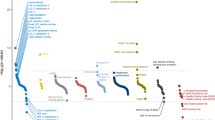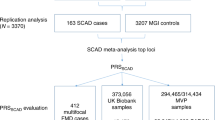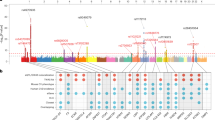Abstract
The complexity of recognizing the potential contribution of a number of possible predictors of complex disorders is increasingly challenging with the application of large-scale single nucleotide polymorphism (SNP) typing. In the search for putative genetic factors predisposing to coronary artery restenosis following balloon angioplasty, we determined genotypes for 94 SNPs representing 62 candidate genes, in a prospectively assembled cohort of 342 cases and 437 controls. Using a customized coupled-logistic regression procedure accounting for both additive and interactive effects, we identified seven SNPs in seven genes that, together, showed a statistically significant association with restenosis incidence (P <0.0001), accounting for 11.6% of overall variance observed. Among them are candidate genes for cardiovascular pathophysiology (apolipoprotein-species and NOS), inflammatory response (TNF receptor and CD14), and cell-cycle control (p53 and p53-associated protein). Our results emphasize the need to account for complex multi-gene influences and interactions when assessing the molecular pathology of multifactorial medical entities.
This is a preview of subscription content, access via your institution
Access options
Subscribe to this journal
Receive 6 print issues and online access
$259.00 per year
only $43.17 per issue
Buy this article
- Purchase on Springer Link
- Instant access to full article PDF
Prices may be subject to local taxes which are calculated during checkout
Similar content being viewed by others
References
McBride W, Lange RA, Hillis LD . Restenosis after successful coronary angioplasty. Pathophysiology and prevention N Engl J Med 1988 318: 1734–1737
Mintz GS, Popma JJ, Pichard AD, Kent KM, Satler LF, Wong C et al . Arterial remodeling after coronary angioplasty: a serial intravascular ultrasound study Circulation 1996 94: 35–43
Van Belle E, Bauters C, Hubert E, Bodart JC, Abolmaali K, Meurice T et al . Restenosis rates in diabetic patients. A comparison of coronary stenting and balloon angioplasty in native coronary vessels Circulation 1997 96: 1454–1460
Samani NJ, Martin DS, Brack M, Cullen J, Chauhan A, Lodwick D et al . Insertion/deletion polymorphism in the angiotensin-converting enzyme gene and risk of restenosis after coronary angioplasty Lancet 1995 345: 1013–1016
Hoh J, Wille A, Zee R, Cheng S, Reynolds R, Lindpaintner K et al . Selecting SNPs in two-stage analysis of disease association data: a model-free approach Ann Hum Genet 2000 64: 413–417
Chen CC, Lu RB, Chen YC, Wang MF, Chang YC, Li TK et al . Interaction between the functional polymorphisms of the alcohol-metabolism genes in protection against alcoholism Am J Hum Genet 1999 65: 795–807
Rice JP, Rochberg N, Neuman RJ, Saccone NL, Liu KY, Zhang X et al . Covariates in linkage analysis Genet Epidemiol 1999 17 (Suppl 1): S691–S695
Casterella PJ, Teirstein PS . Prevention of coronary restenosis Cardiol Rev 1999 7: 219–231
Libby P, Schwartz D, Brogi E, Tanaka H, Clinton SK . A cascade model for restenosis. A special case of atherosclerosis progression Circulation 1992 86 Suppl 6: III47–III52
Biasucci LM, Liuzzo G, Buffon A, Maseri A . The variable role of inflammation in acute coronary syndromes and in restenosis Semin Interv Cardiol 1999 4: 105–110
Best PJ, Hasdai D, Sangiorgi G, Schwartz RS, Holmes DR Jr, Simari RD et al . Apoptosis. Basic concepts and implications in coronary artery disease Arterioscler Thromb Vasc Biol 1999 19: 14–22
Mancini GB, Simon SB, McGillem MJ, LeFree MT, Friedman HZ, Vogel RA . Automated quantitative coronary arteriography: morphologic and physiologic validation in vivo of a rapid digital angiographic method Circulation 1987 75: 452–460
Alfonso F, Macaya C, Goicolea J, Iniguez A, Hernandez R, Zamorano J et al . Intravascular ultrasound imaging of angiographically normal coronary segments in patients with coronary artery disease Am Heart J 1994 127: 536–544
Cheng S, Grow MA, Pallaud C, Klitz W, Erlich HA, Visvikis S et al . A multilocus genotyping assay for candidate markers of cardiovascular disease risk Genome Res 1999 9: 936–949
Stevens PA, Brown MJ . Genetic variability of the ET-1 and the ETA receptor genes in essential hypertension J Cardiovasc Pharmacol 1995 26 Suppl 3: S9–S12
Hubacek JA, Rothe G, Pit'ha J, Skodova Z, Stanek V, Poledne R et al . C(−260)→T polymorphism in the promoter of the CD14 monocyte receptor gene as a risk factor for myocardial infarction Circulation 1999 99: 3218–3220
Mastuura S, Kishi F . Investigation of the polymorphic Avall site by a PCR-based assay at the human CD18 gene locus Hum Genet 1994 93: 721
Behague I, Poirier O, Nicaud V, Evans A, Arveiler D, Luc G et al . Beta fibrinogen gene polymorphisms are associated with plasma fibrinogen and coronary artery disease in patients with myocardial infarction. The ECTIM Study. Etude Cas-Temoins sur l'Infarctus du Myocarde Circulation 1996 93: 440–449
Zhang B, Ye S, Herrmann SM, Eriksson P, de Maat M, Evans A et al . Functional polymorphism in the regulatory region of gelatinase B gene in relation to severity of coronary atherosclerosis Circulation 1999 99: 1788–1794
van den Velden PA, Reitsma PH . Amino acid dimorphism in IL1A is detectable by PCR amplification Hum Mol Genet 1993 2: 1753
di Giovine FS, Takhsh E, Blakemore AI, Duff GW . Single base polymorphism at −511 in the human interleukin-1 beta gene (IL1 beta) Hum Mol Genet 1992 1: 450
Pociot F, Molvig J, Wogensen L, Worsaae H, Nerup J . A Taql polymorphism in the human interleukin-1 beta (IL-1 beta) gene correlates with IL-1 beta secretion in vitro Eur J Clin Invest 1992 22: 396–402
Bergholdt R, Karlsen AE, Johannesen J, Hansen PM, Dinarello CA, Nerup J et al . Characterization of polymorphisms of an interleukin 1 receptor type 1 gene (IL1RI) promotor region (P2) and their relation to insulin-dependent diabetes mellitus (IDDM). The Danish Study Group of Diabetes in Childhood Cytokine 1995 7: 727–733
Tarlow JK, Blakemore AI, Lennard A, Solari R, Hughes HN, Steinkasserer A et al . Polymorphism in human IL-1 receptor antagonist gene intron 2 is caused by variable numbers of an 86-bp tandem repeat Hum Genet 1993 91: 403–404
Aldred MA, Wright AF . PCR detection of existing and new polymorphism at the TIMP locus Nucleic Acids Res 1991 19: 1165
Vinasco J, Beraun Y, Nieto A, Fraile A, Pareja E, Mataran L et al . Heat shock protein 70 gene polymorphisms in rheumatoid arthritis Tissue Antigens 1997 50: 71–73
Sjalander A, Birgander R, Kivela A, Beckman G . p53 polymorphisms and haplotypes in different ethnic groups Hum Hered 1995 45: 144–149
Heighway J, Mitchell EL, Jones D, White GR, Santibanez Koref MF . A transcribed polymorphism and sub-localization of MDM2 Hum Genet 1994 93: 611–612
Acknowledgements
Supported by a Grant HG00008 from the National Institute of Health (JO), and a Research Development Award K04–HL–03138–01 from the National Heart, Lung, and Blood Institute (KL).
Author information
Authors and Affiliations
Corresponding author
Rights and permissions
About this article
Cite this article
Zee, R., Hoh, J., Cheng, S. et al. Multi-locus interactions predict risk for post-PTCA restenosis: an approach to the genetic analysis of common complex disease. Pharmacogenomics J 2, 197–201 (2002). https://doi.org/10.1038/sj.tpj.6500101
Received:
Revised:
Accepted:
Published:
Issue Date:
DOI: https://doi.org/10.1038/sj.tpj.6500101
Keywords
This article is cited by
-
Genetic risk factors for restenosis after percutaneous coronary intervention in Kazakh population
Human Genomics (2016)
-
Detecting disease-associated genotype patterns
BMC Bioinformatics (2009)
-
Variable selection in logistic regression for detecting SNP–SNP interactions: the rheumatoid arthritis example
European Journal of Human Genetics (2008)
-
Bayesian inference of epistatic interactions in case-control studies
Nature Genetics (2007)
-
The challenge for genetic epidemiologists: how to analyze large numbers of SNPs in relation to complex diseases
BMC Genetics (2006)



